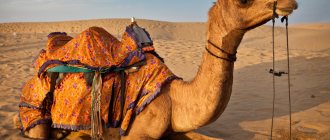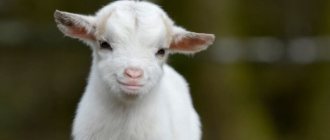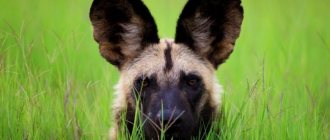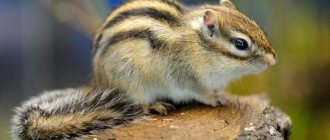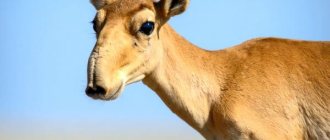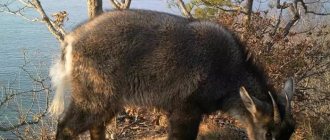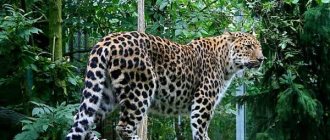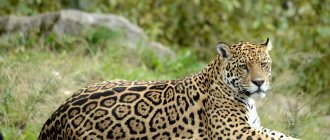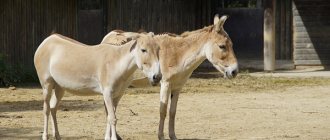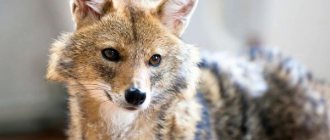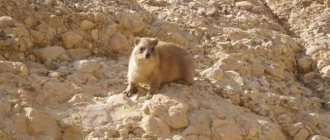What does it look like
The domesticated camel is slightly different from the wild one: its humps are much smaller and sharper. In general, these representatives of callosopods are very large: their height can range from 2 to 2.3 meters. The animals have a barrel-shaped body, a long neck with curves, a large head and eyes that are protected by two rows of eyelashes. Animals naturally have humps, which can fall off if the animal has lost too much weight.
They were called calloused because of the special structure of the leg, which has a forked foot that rests on a calloused pad. This is necessary in order to move calmly on the sand. There is a small claw on the front side of the foot. The animal's tail is small and ends in a tassel of wool. Camels have very unusual lips - their skin is very rough, because even-toed ungulates feed on thorns. The animals' ears are round, and they have special glands at the back of their heads that help mark territory with the help of an odorous secretion.
Camel fur is usually brownish, but can also be sandy in color. It is usually thick and reaches a height of 6 centimeters. Wool consists of guard hairs, which are hollow. Because of this, the thermal conductivity of the cover is low. Molting in animals is peculiar; it does not last long, and it begins in the warm season. The fur usually falls out in large clumps, and new hair does not grow immediately, but only after a couple of weeks.
Lifestyle
The Bactrian camel is perfectly adapted to life in the desert. It has two layers of fur, long eyebrows and eyelashes, and nostrils that close tightly (in most other mammals, including humans, they are constantly open). Thus, the camel's eyes and respiratory tract are reliably protected from dust and sand. The winter coat is thick and dense, protecting against the cold. In summer, most of it falls out, and denser areas remain only on the back, head and front of the neck for protection from the sun. When temperatures begin to rise, camel hair falls out so quickly that they take on an almost mangy appearance at this time. This rapid change allows animals to live in extremely varied and harsh habitats with temperatures ranging from -30 °C to +50 °C.
Bactrian camel - description for children
These artiodactyls have features that help them survive in very extreme conditions. For example, Bactrian camels can experience severe dehydration, characterized by a loss of 40% of fluid. Animal kidneys are capable of absorbing water from urine and delivering it back. Animal red blood cells are oval, so even when the blood is very thick, it remains fluid. These blood cells can also store water. Camel manure is concentrated and consists almost entirely of dry plant fibers.
It is also interesting that the animal’s nostrils are closed; it opens them only when it breathes. Thanks to this, less water evaporates. Another interesting feature is that a camel can only sweat if the temperature rises to 41 degrees. If it continues to rise, it becomes dangerous for the animal's life. At night, the camel's body has a temperature of +34.
Spreading
They are widespread in Central Asian and Central Asian countries, Mongolia, China and the southern regions of Russia.
In natural habitats, they were first discovered and described by traveler and naturalist Nikolai Przhevalsky in 1878.
Camelus ferus live in small groups of 6 to 20 individuals in the Gobi (Mongolia) and Taklamakan deserts in western China. The Mongolian population is considered the most numerous, numbering more than 600 individuals.
In the Chinese province of Gansu, Lop Nur Wild Camel National Park was created in 2000 to preserve these rare animals. Despite all the measures taken, with the current ratio of mortality and birth rates, the number of the species in the next 20 years may decrease by another 15-17%.
Where does it live?
Previously, wild camels could be found throughout almost all of Central Asia, but now they live only in Mongolia and China. In its homeland this species is called haptagai. Today, this species migrates frequently, but in general individuals prefer plains with little food and water. However, this is very important for animals, they depend on springs and other sources of water. After the rain stops, groups of animals gather near rivers, where small spills appear. In winter, camels can easily make do with snow.
Khaptagai can be found in mountainous areas; they can move along slopes better than mountain sheep. In summer, animals rise several thousand meters above sea level. In winter they migrate south and live in mountain valleys where they can be protected from the wind. If oases are free, they spend a lot of time near them. In general, migration is typical for this species; this may be associated with oases. Numerous observations show that animals are capable of walking about 100 km per day.
The domestic camel lives in Central Asia, eastern Asia and often near Russia. Now there are already more than two million Bactrians. Today, Kazakh and Kalmyk breeds are bred.
Kinds
There are two main types of desert animals - the one-humped camel (dromedar) and the two-humped camel (Bactrian).
Distinctive features of Bactrian:
- two humps;
- covering most of the body with fur;
- massive body;
- short facial bones and wide eye sockets;
- curved but short neck;
- in the area of the forearms, beard and head, the hair becomes stiffer, forming a kind of mane;
- short legs.
The camel's fur is thin, but brushed, which allows the animal to survive in cold areas without suffering from cold and temperature changes. In Bactrians, the distance between the two humps is not filled with fat, and the sacral part of the body and shoulders are very poorly developed. Bactrians are practically not suitable for caravans.
Species features of the dromedary:
- one small hump;
- short hair;
- long legs;
- long facial bones and convex frontal part;
- mobile, thin lips, plump cheeks;
- small body;
- long and very agile neck;
- thin skin and light bones;
- Pregnancy in female dromedaries proceeds three weeks faster than in Bactrians.
In addition to the two types of animals, there are subspecies - hybrids bred in mountainous areas.
Hybrids:
- Nar and nar – maya (females). In appearance it strongly resembles a dromedary, but their hump is elongated. Camel offspring are larger than their parents. A special feature of the Nara is the ability to reproduce, which is not typical for hybrids, but the cubs of these camels usually do not survive; they are very sick and weak.
- Iner. It is distinguished by a powerful body, good coat and a large, long hump. Iner females produce large amounts of milk.
- Jarbay. This hybrid is extremely rare, which is associated with sickness and weakness of the offspring.
- Kospak. Large hybrid, produces a large amount of milk.
- Kurt and kurt - people. Hybrid, dromedary camels. The animal is distinguished by slightly drooping forearms and high production of low-fat milk.
- Kama, an unusual hybrid, in the creation of which they used not only a camel, but also another animal similar in structure - a llama. Outwardly, this camel looks more like a llama - it does not have a hump and has short, coarse hair. Kama can also carry a lot of weight.
camel caravans include strong and durable animals, which not only easily carry large loads, but can also travel for a long time without falling.
Lifestyle and social organization
These representatives of callosopods are especially active during the daytime. At night they sleep or chew plants. If they get caught in a hurricane, they can lie motionless for days. In bad weather, animals try to hide in ravines; in hot weather, they use their tails as fans, fanning themselves with them and opening their mouths. This allows you to lower your body temperature.
Social organization is usually controlled by people, but in the event of savagery they create their own orders. Usually they try to stay in a herd of several dozen individuals. These groups consist of females and young representatives of camelids. But sometimes you can meet young males there, but strictly not during the rutting period. The dominant male becomes the most important member of the herd. Old males often live alone.
Well-deserved rest
In the hottest time and at night, camels lie down to rest - in an open place, in order to notice the enemy in time. But not all animals rest - the leader is always on guard. Stretching his neck, he slowly turns his head in all directions, carefully surveying the surroundings. If a herd of camels is wild, then at the slightest danger, after a signal from the leader, it takes to its heels and runs for many kilometers without stopping. During hurricanes, animals can lie motionless for several days, fleeing sand flying into their eyes. When a storm arises, the camel's nostrils close tightly to protect the airways. A camel's ears are protected by fur, and its eyes are protected by two rows of long eyelashes, as well as a transparent eyelid. If sand still clogs your eyes, they begin to water, washing away the debris. When it rains, camels take shelter in bushes or ravines. These amazing animals live quite a long time - on average 40-60 years. But in old age they are no longer used for hard work, being on a well-deserved rest. But even at an active age, they have time off to recuperate. Camels typically work as pack animals for 6-8 months of the year, after which they are given time off to rest and breed.
Magazine: Secrets of the 20th Century No. 30, August 2008 Category: Our neighbors on the planet Author: Elena Alexandrova
Tags: Secrets of the 20th century, water, animals, animals, desert, nomads, heat, camel
- Back
- Forward
What does it eat?
Bactrian camels eat grasses, prefer camel thorn, and may eat shrubs or subshrubs such as barnyard grass and onions. They can also eat saxaul with ephedra, and sometimes they eat poplar and reeds if they grow near oases. During periods of severe hunger, they may eat the skins of other animals or their bones. However, this rarely happens, since camels are well adapted to fasting, so domestic camels need a little underfeeding.
These artiodactyls also rarely drink water, usually once every couple of days. If it is impossible to approach a watering hole, then they can wait for weeks, especially in the summer, because that is when there is a lot of water in the plants. It accumulates there after rain. Animals can drink both fresh and salt water. Sometimes, during periods of severe dehydration, they are able to drink about a hundred liters of water at a time. In general, wild camels have a high need for salt intake, so it is better to give domesticated animals salt bars.
If the food supply is excellent, these representatives of callosopods gain a lot of weight closer to autumn. However, these animals suffer more from ice in the winter, because they do not have real hooves and therefore cannot dig at this time to get well-hidden vegetation.
Nutrition
The diet of Bactrian camels consists of food of plant origin. They are not picky eaters and can feed on almost any plant, including salty, bitter and with an abundance of thorns, which other herbivorous mammals are not able to eat.
The food is lightly chewed, swallowed and ends up in the forestomach (rumen), where the fiber is pre-digested by cellulolytic bacteria. Then it again enters the oral cavity and is chewed again.
This resembles the digestive system of Ruminants (Ruminantia), to which Bactrians do not belong. They also have four-chambered stomachs, but their structure is completely different. The main difference is the presence of digestive glands in the rumen, which allows for more efficient digestion of low-nutrient foods.
Camels can quench their thirst in bodies of mixed and salt water. Within 10 minutes they are able to drink up to 120 liters of liquid.
The main plants eaten are feather grass (Stipa), fescue (Festuca), wild oats (Avena fatua), wormwood (Artemisia) in the steppe zone and saxaul (Haloxylon) in the deserts. In the absence of usual food products for a long time, animals are content with bones, skins or fish.
Offspring and reproduction
Sexual maturity in females occurs at about 2 years, and in males at 5 years. The rutting period begins in the fall, which causes aggressive behavior in males. They begin to try to start mating with females, scream, and constantly run around foaming at the mouth. Dominant males at this time gather the females and do not allow them to leave. In this state, the male animal is very dangerous; domestic animals are usually tied. In the homeland of the Khaptagai, such animals can be seen from afar: they are wearing red headbands.
During this period, males constantly start fights, try to strangle the enemy and throw them to the ground. Even the calmest animals begin to get into fights, use fangs and kick. In this case, most likely the fight will end in the death of the enemy, so shepherds often intervene in the process, saving the weak male. Sometimes wild Bactrian camels take away domesticated females and kill the males. For this reason, shepherds in Mongolia take “domestic” calloused animals to the mountainous areas.
During the rutting season, males constantly mark their territory; to do this, they only need to touch the ground with their heads. They use urine to water their legs and the rest of the back of the body. The tail helps the males with this. Females do the same. Animals mate in a lying position. 13 months after mating, the female gives birth to one cub, which weighs only 30-40 kg, in contrast to the one-humped one, which weighs almost a hundredweight.
Within a few hours, the newborn begins to follow its mother. Usually, after birth, he already has some rudiments of humps, but there is no fat in them. He appears after a few months. The mother feeds the baby milk for about 3 months, although even then the baby camel begins to taste leaves and shoots of plants. Sometimes the female continues to give milk to the child for up to a year or up to a year and a half. The offspring grow quite quickly, although after they become sexually mature, this process slows down. Camels stop growing at about 7 years of age.
Around 3 years old, young males leave the herd, begin to create groups of relatives and then create their own harem. The female usually gives birth to a cub once every few years.
Keeping animals at the Moscow Zoo
Camels are not only one of the most common animals in zoos, but also one of the most beloved. What child would leave the zoo without seeing a camel! In the history of the Moscow Zoo, it seems, there was no period when we lived without camels, and both two-humped and one-humped camels were kept. Each had their own character, their own habits. The one-humped camel Pan was a feisty one and always tried to grab a person passing by by the head. And the two-humped giant Senya, who came to us from VDNKh, was, on the contrary, an amazing kind person.
When the zoo was being reconstructed, animals were transferred from one area to another. The camel Manka, Senya’s friend, was completely tame and simply followed the call of a familiar person who was holding a piece of bread in his hand. And a funny thing happened to Senya. The staff did not know that he had been bridle trained before and expected the camel to move away from the accessory. Senya, joyfully, but rather sharply moved his huge forehead head towards the man with the bridle, which caused quite a strong fright. It turned out that he was simply delighted with an object familiar from childhood and, happily putting on the bridle, calmly crossed Bolshaya Gruzinskaya Street.
Now the camel can be seen in the New Territory of the zoo; its enclosure is located opposite the entrance to the Exotarium. This is a female, more than 20 years ago she came from the Astrakhan region and now lives with Przhealsky horses, and this company suits everyone quite well. The animals do not show the slightest hostility towards each other, but if the horse presses its ears back (and this is a sign of dissatisfaction), the camel moves away. The camel often approaches visitors, who run away exclaiming: “Oh, he’s about to spit!” There is no need to be afraid, this peace-loving animal spits extremely rarely, only at veterinarians when it is being vaccinated. You don’t need to feed him either; all the animals in the zoo receive the food they need and is healthy for them. The camel is given hay, branches (which it prefers to hay), a mixture of cut vegetables and oats. Be sure to have a salt lick with a special set of salts in the feeder. The beast comes to talk to you. Smile at him!
